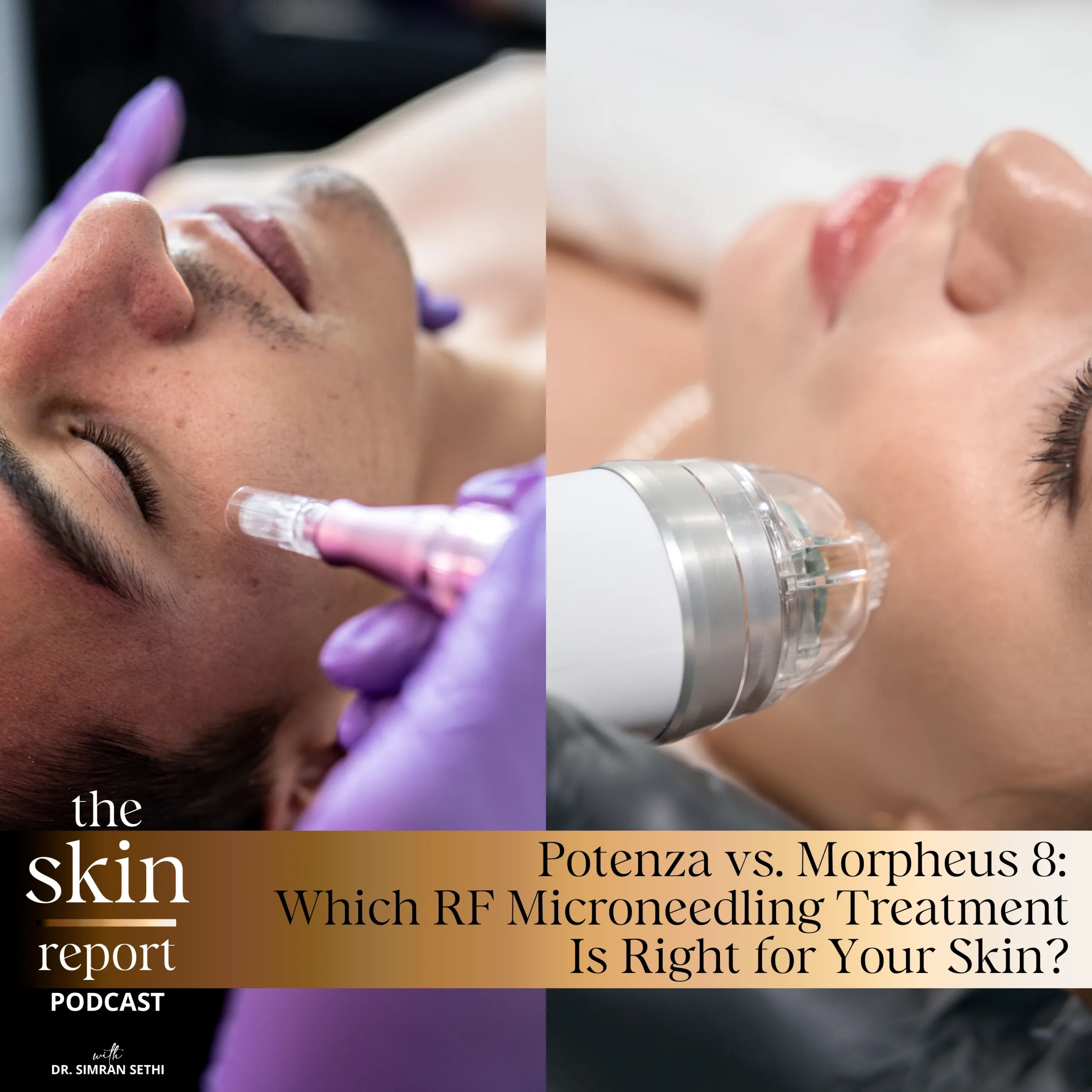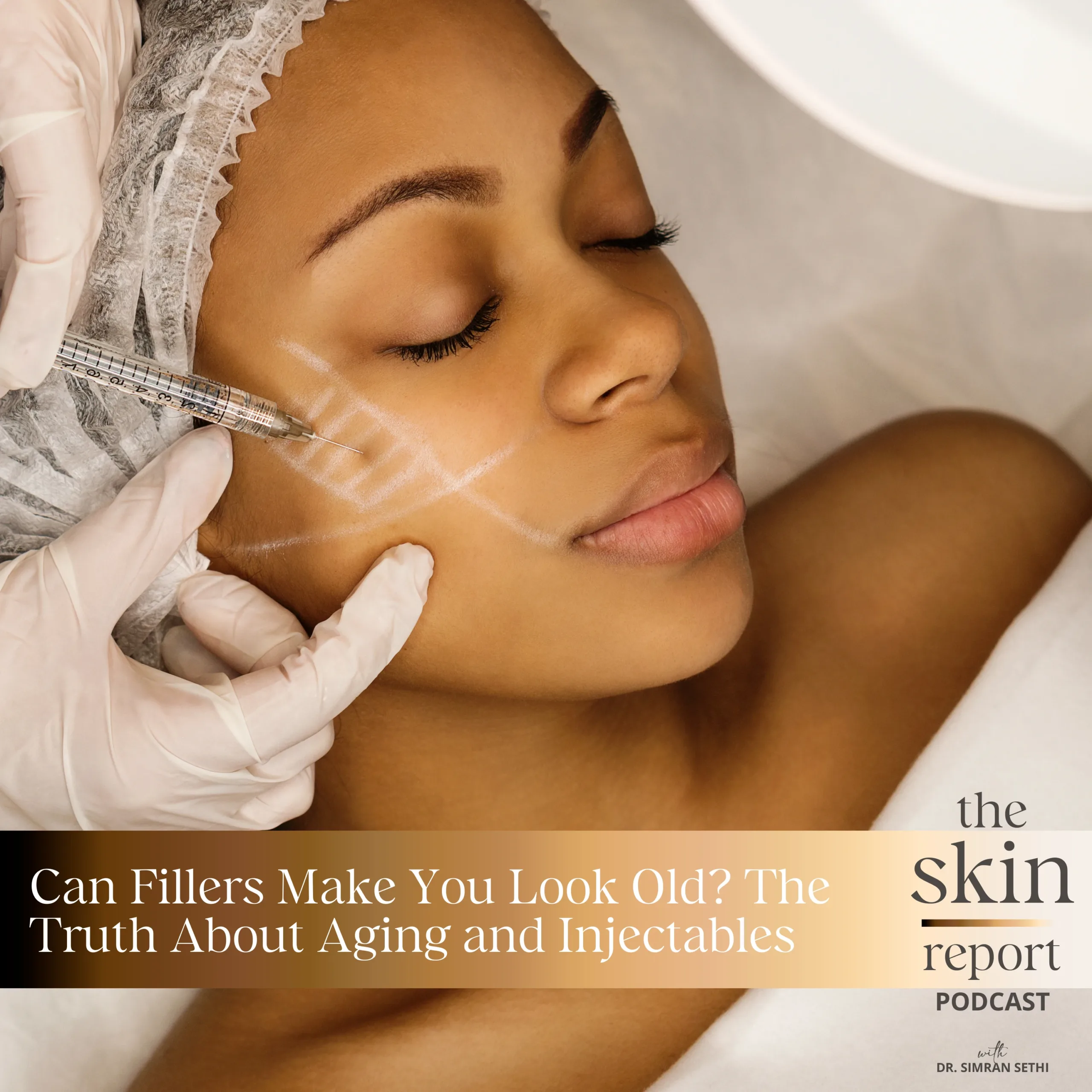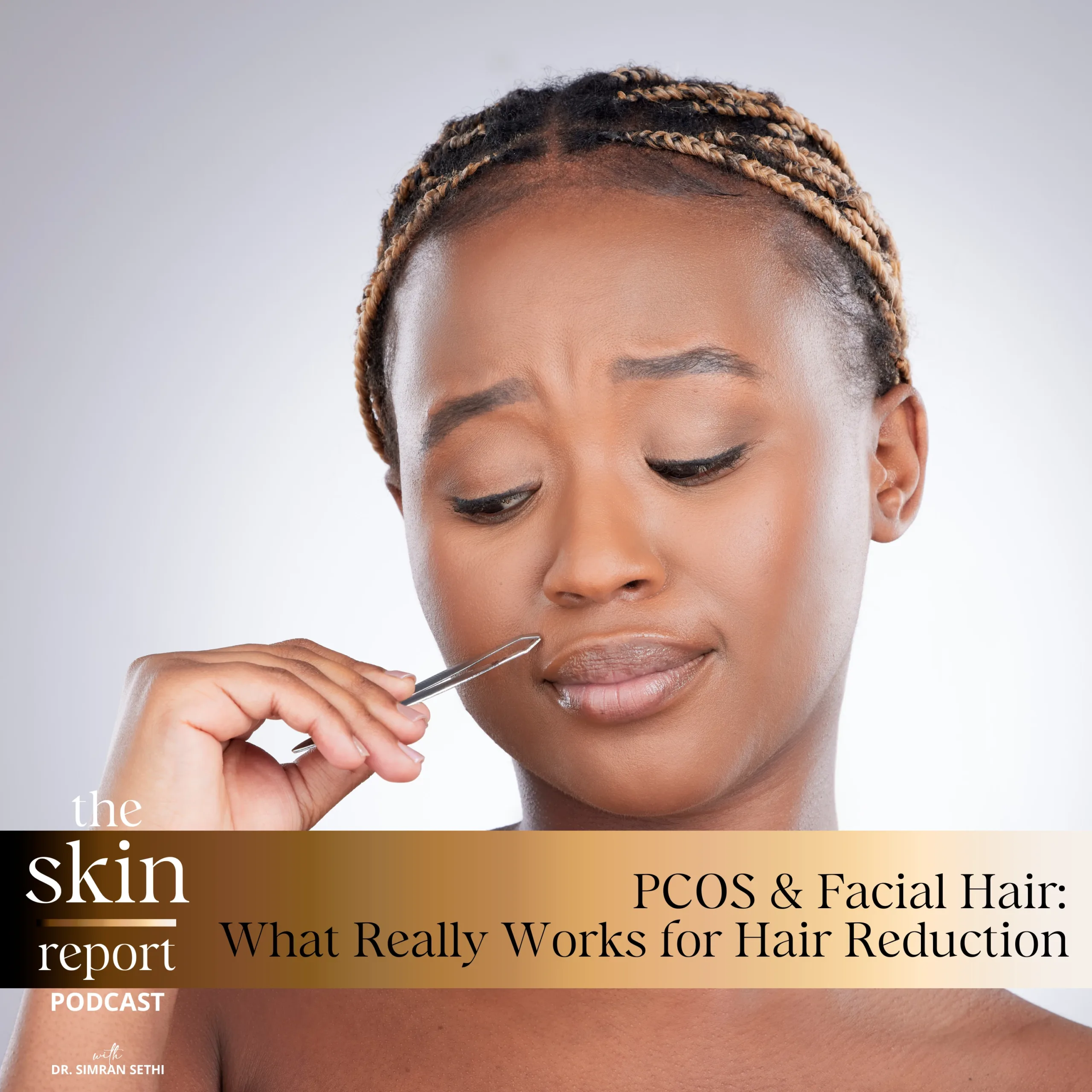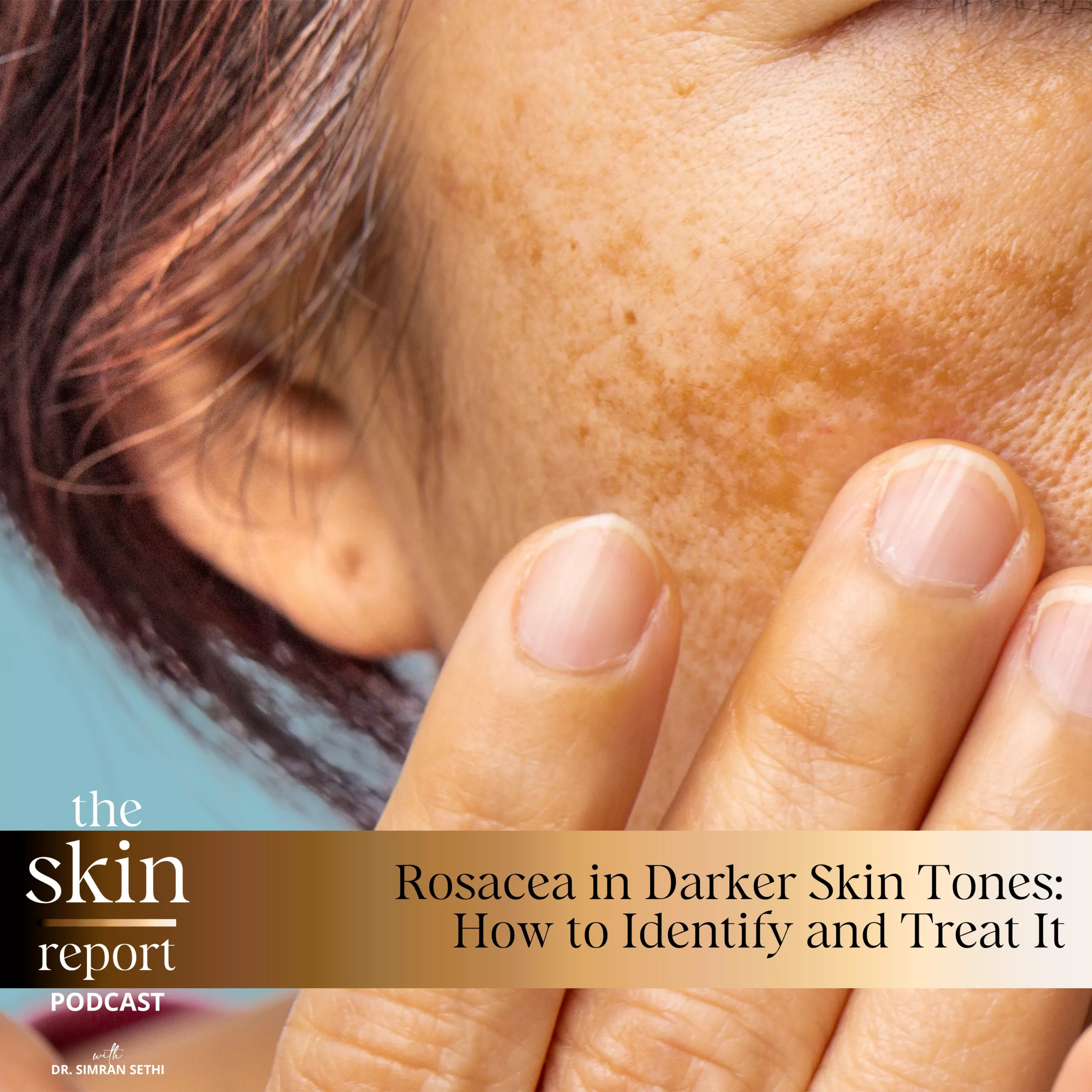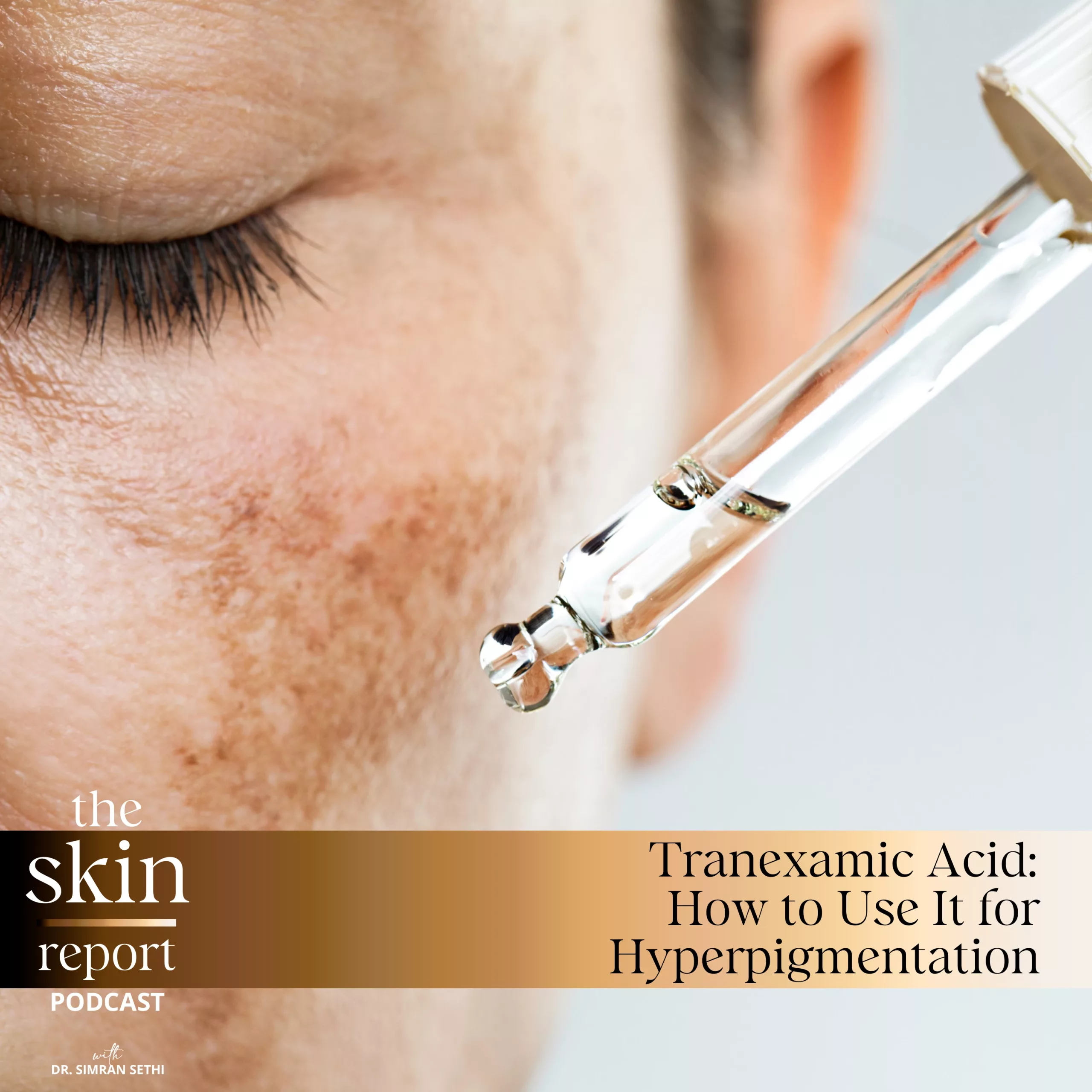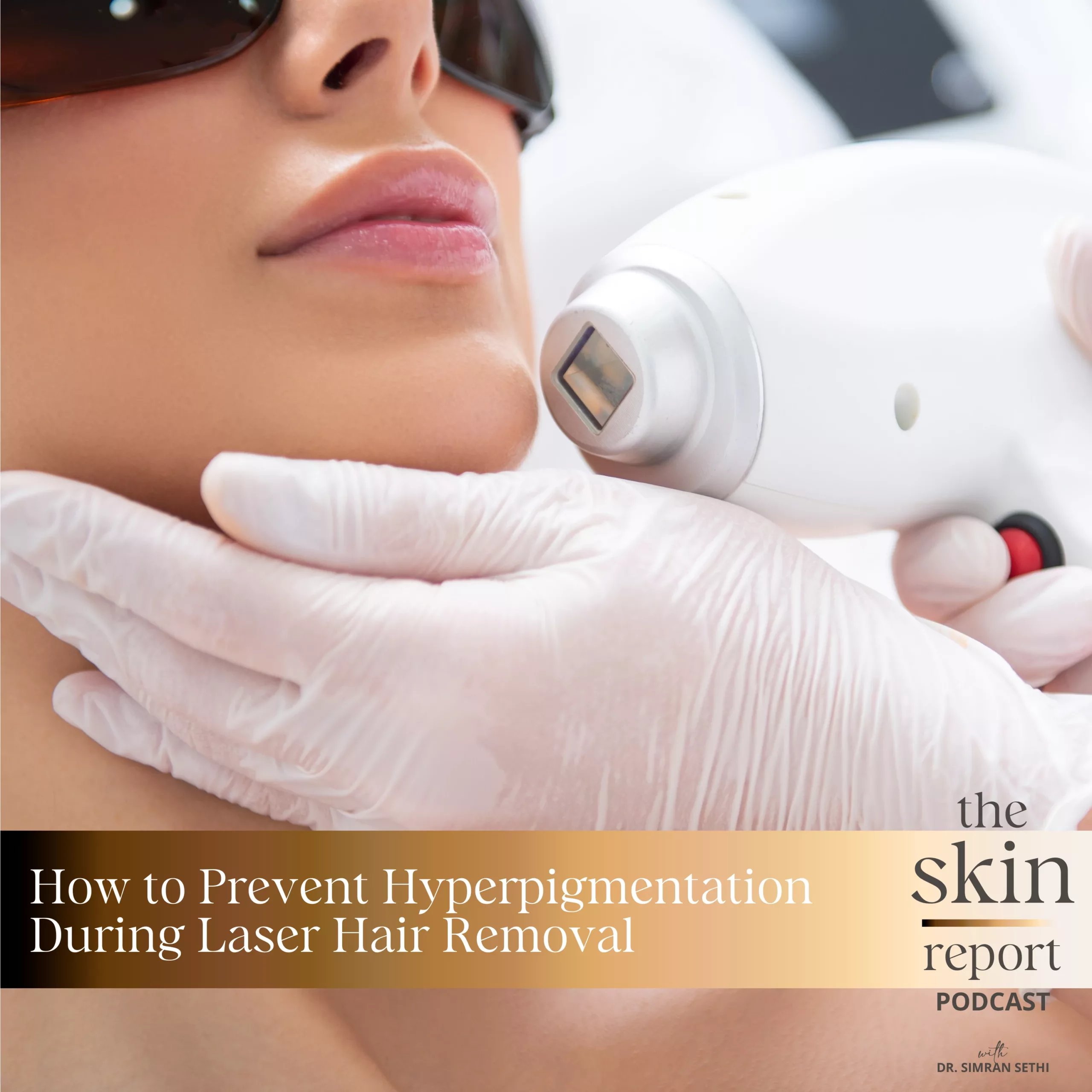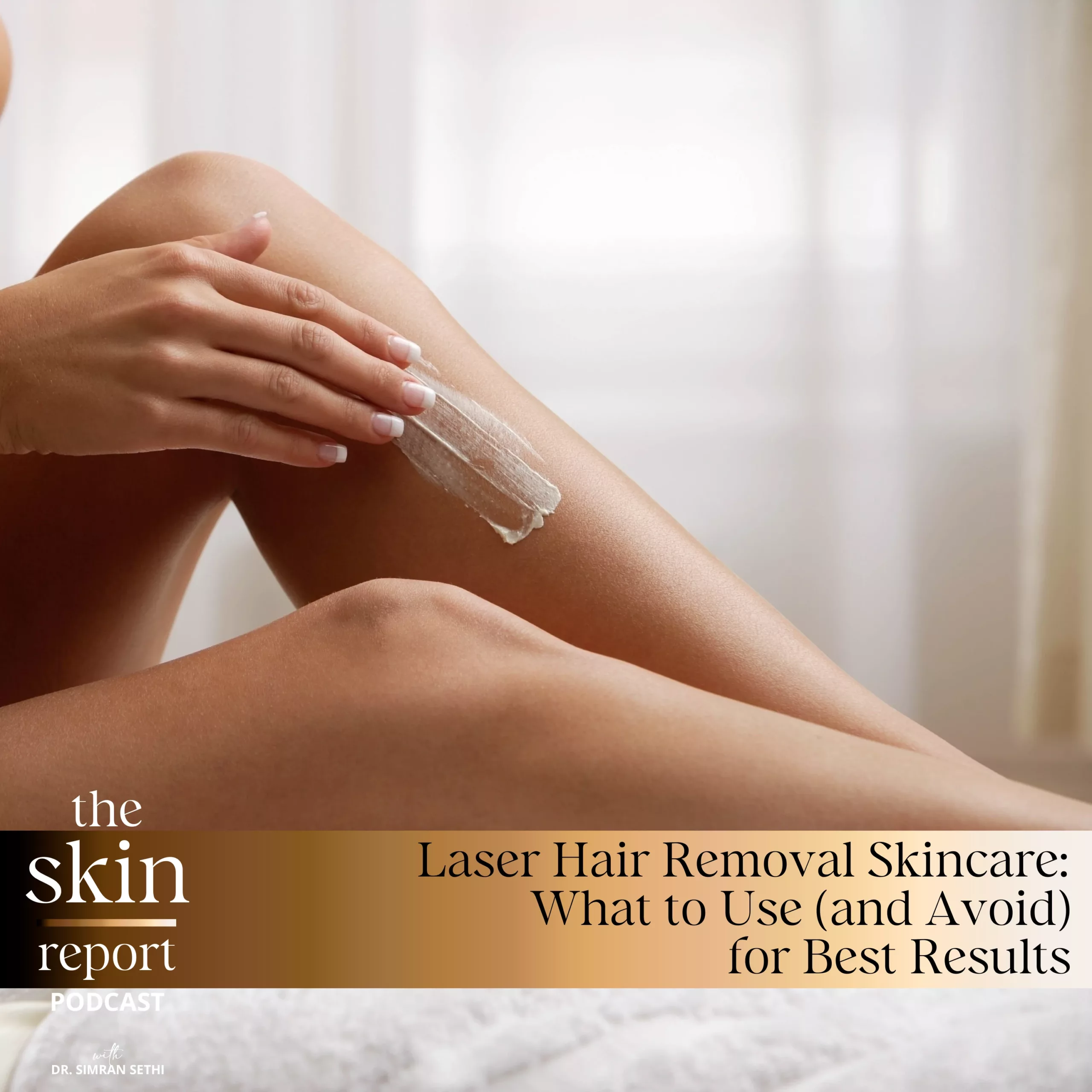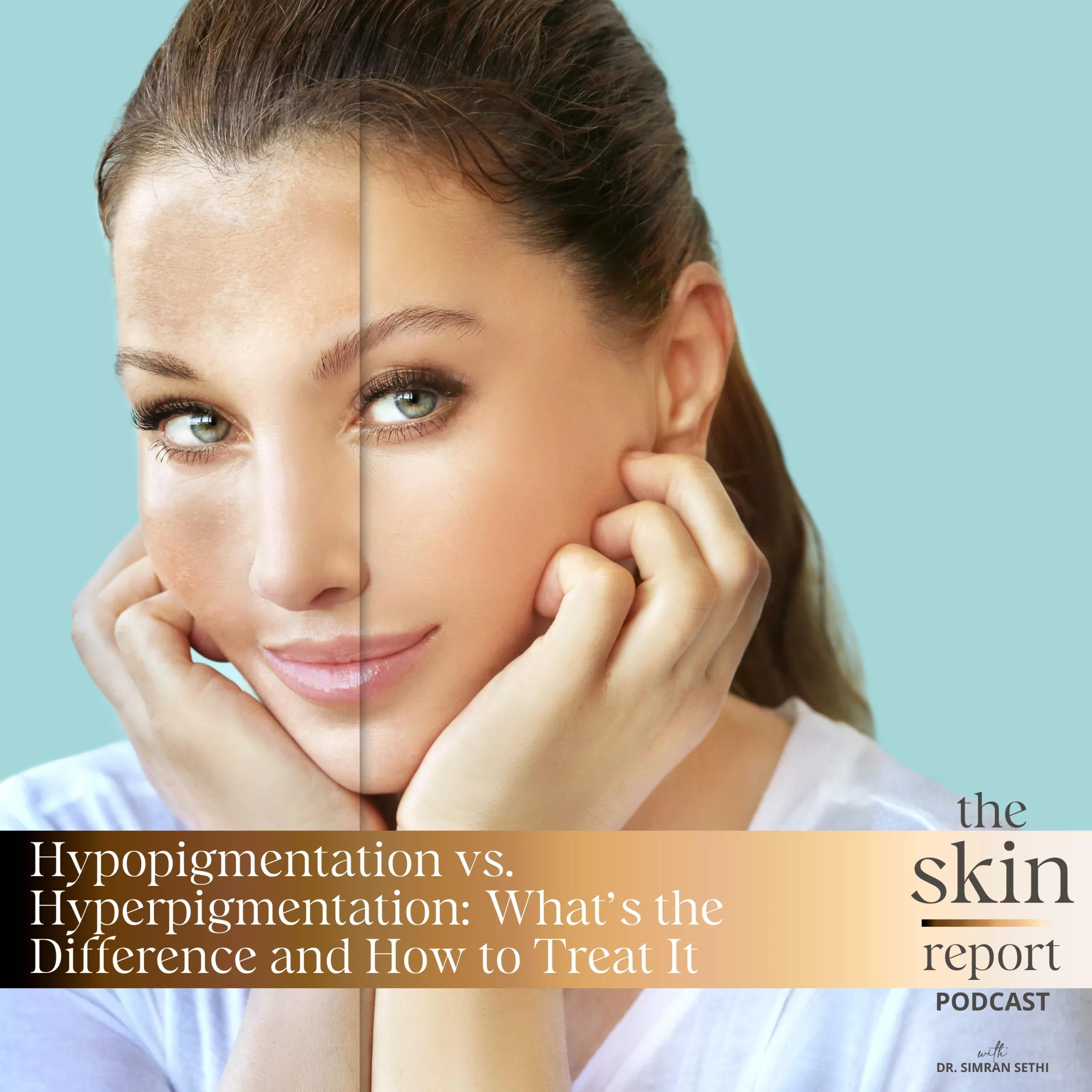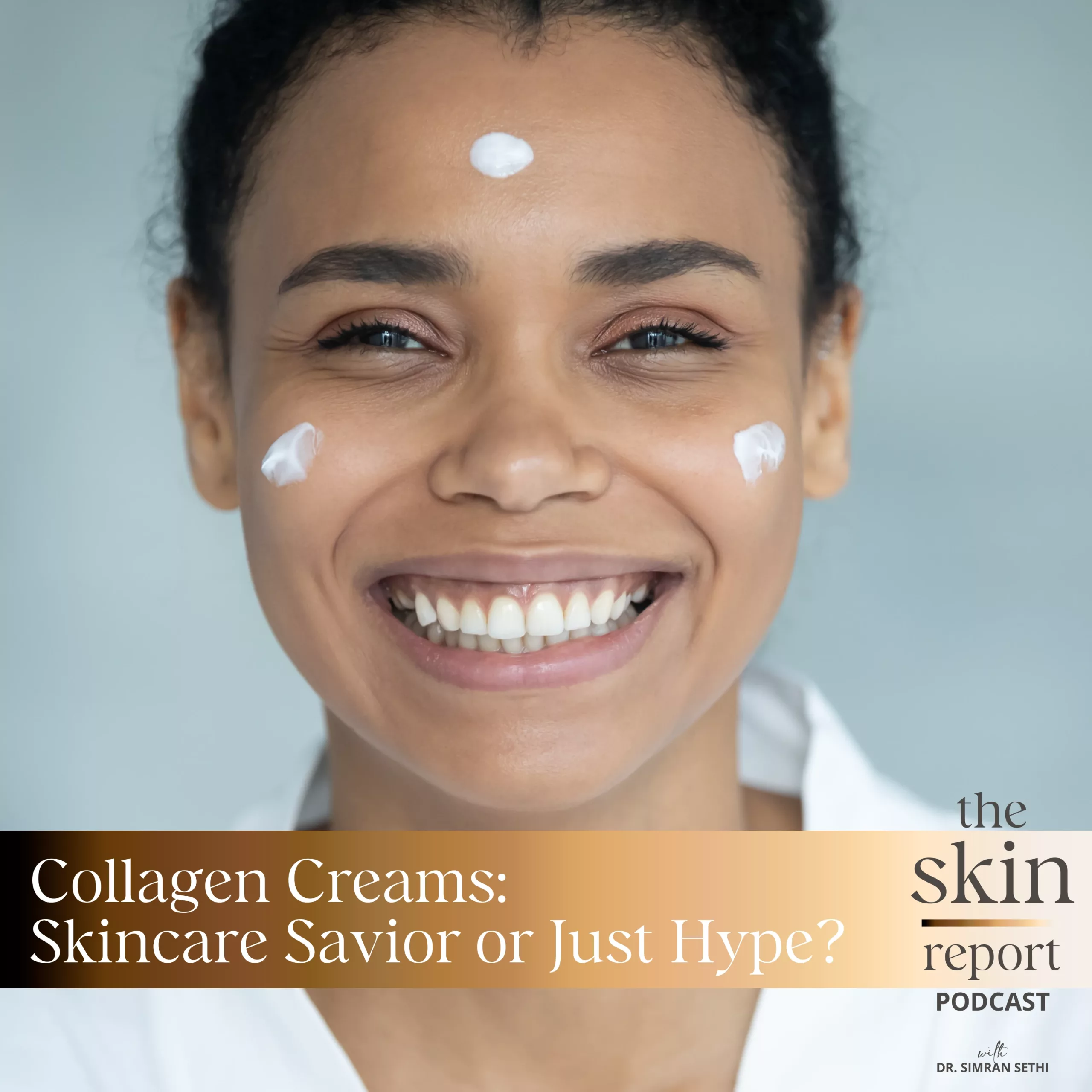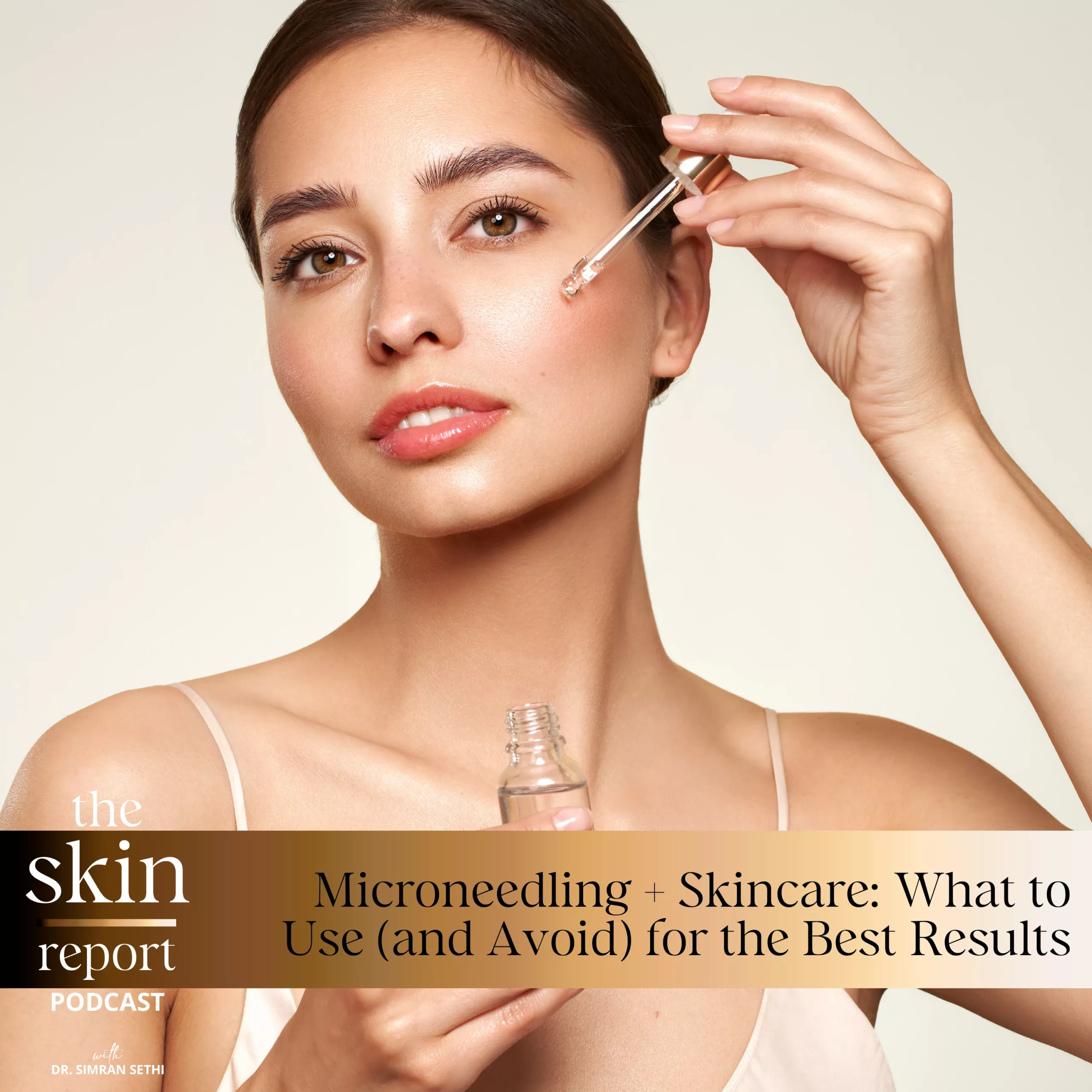Vitamin C Buyer’s Guide
It seems like everyone is incorporating vitamin C into their skincare routines these days, as it can help people achieve a clear and even complexion. However, you should know that the quality and stability of your vitamin C can depend on its type, formula, and even the packaging it comes in. Choosing the wrong vitamin C product can leave you with a formula that becomes oxidized early and loses its usefulness. That’s why this episode goes over everything you need to know to purchase an effective product!
The Skin Report is a podcast created to educate listeners on methods to improve skin health for people of all ethnicities and ages. On this episode, host Dr. Sethi discusses the function of vitamin C in skincare. She goes over how it interacts with free radicals to improve skin health and its safety for use on different skin tones. In addition, Dr. Sethi breaks down the types of vitamin C, Tetrahexadecyl Ascorbate (THD), and L- ascorbic acid and their differences in effectiveness, stability, irritation, and strength. Listeners will also learn How to choose a long-lasting and effective vitamin C product and other ingredients that boost vitamin C’s effects.
Follow and DM a question for Dr. Sethi to answer on The Skin Report Podcast:
Renew Beauty Instagram:
https://www.instagram.com/renewmd_beauty/
RenewMD Beauty Medical Spas, California:
https://renewmdwellness.com/
The Skin Report Season 1 Episode 5: Determining Skin Type:
https://theskinreportbydrsethi.com/s1e5-determining-skin-type/
Skin Cycling Duo Special Offer 20% off Promo Code:
SKINREPORT20
This transcript was exported on May 9, 2023 -view latest version here.
Skincare can sometimes feel overwhelming, whether it’s finding the right products, ingredients, or treatments. There’s a lot out there, but not always for people of African, Hispanic, middle Eastern and Eastern South Asian descent. That’s why I set out to educate myself and others so that we can all feel beautiful in our skin. Hello and welcome back to the Skin Report. I’m Dr. Simran Sethi, an internal medicine doctor, mom of three and CEO and founder of Renew MD Medical Spas and Skin by Dr. Sethi.
I’d like to take a closer look at a skincare superstar that gets a lot of attention online, vitamin C. Did you know the quality and stability of your vitamin C can be impacted by its type, formula, and even the packaging it comes in? That’s right. You could purchase a vitamin C serum that would be rendered useless in only a few weeks after it oxidizes from poor bottle design. But that’s not going to be you because today we’re going to go over everything you need to know to purchase an effective product. So let’s get into it.
With so many options for vitamin C at extremely varying prices, it’s hard to know what to choose. Prices often are a determining factor, and while I completely understand sometimes the upfront cost of a product, no matter how inexpensive can actually be a waste if the product doesn’t work. So I’d like to go over what types of vitamin C, what formulas and what packaging will ensure that your serum doesn’t oxidize and is rendered useless. But before we get to that, let’s refresh our knowledge of the functions of vitamin C. Vitamin C is an antioxidant that hunts down damaging free radicals in the skin to provide real-time protection from UVA and UVB rays, increase collagen production, reduce excess melanin production, and reduce inflammation. Vitamin C is safe for all skin tones, but we’ll continue this point later in the episode. So while many skincare products and ingredients also make these claims, vitamin C can also walk the walk.
Vitamin C has been extensively studied and its effects are backed by multiple clinical studies over many years, and is proven ability makes it a popular active ingredient. However, there’s a lot of talk in competition around its stability and shelf life, but why? Why should we worry about the stability of vitamin C? Vitamin C’s mechanism of action as an antioxidant is to neutralize damaging free radicals, but these are abundant in more than just our skin. They’re always abundant in the air too. So if the vitamin C is not formulated to stay away from binding to free radicals before it enters the skin, it’ll be ineffective in the skin. Also, the skin layer the vitamin C penetrates into before losing its ability to fight free radicals is important. If vitamin C attacks free radicals in just the epidermis where we have pigment production called melanogenesis, and where UVB light penetrates, it’ll only help with reduction of pigment production.
If the vitamin C absorbs into the dermis, it can fight other free radical damage and inflammation to promote collagen production. So an ideal vitamin C would enter the skin in its active state and penetrate into both the epidermis and dermis. Now, when we return, we’ll go over the two types of vitamin C. Yes, you heard that right. Vitamin C can take two different forms performing different properties, so it’s important to understand what your serum has. There are two main types of vitamin C available to us in skincare today. The two forms are tetrahexyldecyl ascorbate, which I’ll refer to as THD, and the more common form, L-ascorbic acid. Though more expensive, I prefer THD for several reasons, which I’ll explain. You’ve probably seen L-ascorbic acid on the back of your vitamin C serum. It’s water-soluble with a lower pH range compared to THD, which is oil soluble with a higher pH range.
Additionally, L-ascorbic acid is less stable than THD, which means it can oxidize when exposed to light and air. Now, what does all this mean and why should you care? Because THD is lipid or oil soluble, it penetrates into the epidermis and dermis where it can promote collagen production, reduce inflammation and uneven melanin production. L-ascorbic acid is water-soluble, which means it will sit on the surface of the skin only addressing concerns in the epidermis. Next is the stability issue. L-ascorbic acid is the less stable form of vitamin C, but this does not mean that it’s unstable when applied to the skin. What it means is that it is more difficult for product manufacturers to formulate it to remain stable before topical application. Essentially, manufacturers and skincare lines are currently competing over the most stable packaging so that by the time you purchase a product and bring it home, it’s still stable and effective.
We’ll touch on what packaging to look out for when buying your serum later in the episode, but for now, it’s important to acknowledge that THD is more stable with a longer shelf life than L-ascorbic acid vitamin C. Another reason why I preferred THD is the strength, sensitivity and pH range, and they’re all connected. Have you ever applied a product with L-ascorbic acid and experienced a burning sensation as if you were applying citrus on your skin directly? As the concentration of S sorbic acid increases, it becomes more irritating on the skin due to its lower pH range. L-ascorbic acid has to be in a formulation of around a pH of 3.5 or lower, which is very acidic and can break your skin barrier. The more acidic L-ascorbic acid is, the more stable it is, however, the more acidic it is, the more you’re likely to experience skin sensitivity.
This is why in some people, including myself, get a burning sensation after applying a vitamin C product with L-ascorbic acid. This burning effect is even more uncomfortable in dry, sensitive or mature skin as these skin types can have micro tears in the skin barrier. And when you apply L-ascorbic acid, this will create a lot more sensitivity. I’ve had patients with darker skin types who appear more pigmented if they have dry or sensitive skin because L-ascorbic acid is just too acidic for their skin. If you have a darker skin tone, L-ascorbic acid will also make your skin look darker and uneven, the opposite of why you want to use vitamin C. Now, skin sensitivity does not occur when using a THD ascorbic vitamin C. THD is at a pH of around 5.5, same PH as our skin, which is why it does not disrupt the skin barrier.
THD is the most stable form of vitamin C delivered to all layers of the skin because it’s actually converted to L-ascorbic acid in the skin and fights free radicals unlike directly applying L-ascorbic acid. So overall, THD is more stable and less irritating than L-ascorbic acid. However, the differences don’t stop there. L-ascorbic acid strengths range anywhere from five to 20%, but 20% formulations tend to be very grainy in consistency, usually having a strong burning sensation on application and don’t spread on the skin as evenly. THD formulations can range from 0.5% to 3%. However, this doesn’t mean that THD is weaker. In fact, the opposite is true. At 3%, THD is eight times stronger than a 20% L-ascorbic acid concentration. So let’s recap. L-ascorbic acid is less expensive and is therefore in a broader range of products, however, it is more irritating, less effective, and less stable than its counterpart THD.
When it comes to vitamin C serums, there are other ingredients than just these two forms. Which ingredients are important to pair with THD or L-ascorbic acid? What boosts their effects and what dilutes them? You may have gathered that THD is my favorite form of vitamin C. In fact, I love it so much. I used it in my own products. I had tried so many different types of popular and expensive vitamin C serums, and they all had been L-ascorbic acid, but just couldn’t handle the burning and sensitivity from them. We all wanted to have a potent vitamin C in our skincare regimen. THD ascorbic has been a game changer for vitamin Cs, and that is why I use it as the main ingredient in my Vita C Restore Serum. This serum has 3% THD ascorbic, which is eight times more potent than L-ascorbic 20% vitamin C.
A vitamin C serum can be fortified with other ingredients for various goals. So let’s say your main goal is anti-aging. You’ll want to look for a serum that also has peptides and lipids, and these will enhance the skin’s integrity, building effects of vitamin C. Peptides can signal increased skin protein production for fighting fine lines. My serum, for example, contains marine algae, which down regulates the expression of a gene associated with skin aging and breakdown. Now, what about collagen? What did a vitamin C serum with collagen further promote anti-aging? Adding collagen protein to skincare will not promote more collagen growth or repair itself. This ingredient in a skincare product will just fill in collagen deficiencies in the skin. And while this may seem good, it’s really just a bandaid. Why not target the root of anti-aging, which is breakdown in collagen itself? As I said, the peptides can do just that.
Additionally, lipids in a serum with vitamin C will help prepare your skin barrier, which is the key to having healthy glowy skin. Now say your goal is to truly combat pigmentation. A serum that contains other pigment down-regulating ingredients like bearberry extract, vitamin E, niacinamide, or kojic acid can help significantly boost the effect of the vitamin C. If you’d like your vitamin C to tackle both pigment and anti-aging, you’ll want a vitamin E combined with vitamin C as these synergistically enhance both antioxidants capabilities. So again, they’re a great combination of ingredients. Now, remember how we said that the true competition in skincare is finding the most stabilized packaging for vitamin C? I want to further dig into why the most common bottle types are ineffective and what to look for instead when buying your serum. As we said, vitamin C can oxidize and become less effective when exposed to light and air.
This makes packaging vitamin C serums a challenge. As a result, you’ll want to stay away from a dropper bottle. I know many serums come and drop her bottles, and if you see this, I still highly advise you to stay away. Remember, vitamin C’s job is to scavenge for free radicals, especially oxygen radicals that are abundant in the air. No matter how stable your vitamin C formulation is, L-ascorbic or THD, and no matter what your manufacturer states, all vitamin C should be in airless packaging. Yes, even a hundred dollars plus formula with THD will still oxidize and no longer work if it has a dropper making it a waste of money. When vitamin C’s attached to a free radical, it is no longer able to accept more radicals to neutralize. This means that it is ineffective just sitting in your bottle because of exposure to air.
Yes, dropper bottles look stylish and cute, but you will definitely notice that your product feels or looks different just after a few weeks of use. This is due to the oxidation of the vitamin C. This also happens with other products, but is most common in vitamin C. Instead, you’ll want to purchase completely opaque packaging. Even products in a tinted glass bottle are not protected enough from light exposure. So if the product is in a glass bottle, it should be opaque or covered entirely by a paper covering. And equally important is to find products with an airless pump as exposure to air, will definitely oxidize vitamin C. Before we wrap up today’s episode, I want to provide a few more insights. First, I’d like to recap that vitamin C is safe for all skin tones, though THD will be less irritating for more melanated skin as it’s less acidic.
When it comes to applying the serum, should we do it at night or during the day? I say both. During the day, your vitamin C is primarily fighting damage from UV exposure. But at night, when the body’s circadian rhythm is actively rebuilding all the organs in our body, vitamin C will be a key driver of collagen synthesis. And as we’re exposed to free radicals externally and internally, wearing vitamin C day and night is the perfect way to experience the full benefits. Lastly, I want to talk about whether you should opt for a serum or another skincare product with vitamin C in it. While combining skincare steps sound appealing, it may not be the most effective approach. I prefer vitamin C serums as they pack in more of a dose of vitamin C. While this can be included in a moisturizer, the amount of vitamin C delivered might vary. Overall, if you layer on a vitamin C serum versus apply a moisturizer or even sunblock containing vitamin C, you are diluting the effects of that vitamin C. Thanks for listening, and until next time, love the skin you’re in and celebrate your beauty.
If you’d like to learn more about science backed skincare or medical aesthetic treatments, please subscribe to and turn on notifications for The Skin Report. So you always know when an episode is up. We have a newsletter that you can sign up for on skinbydrsethi.com so that you can stay up to date on all our latest products and more. Additionally, if you have a skincare question or want to make an episode topic recommendation, please message me at the skinreportbydrsethi.com, which is linked in my show notes, and I’ll be sure to answer your question in an episode soon. We’ve received some great questions so far, and I’ll try and answer them at the end of every episode, so keep them coming.
Transcript by Rev.com


